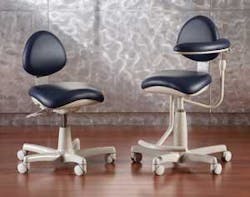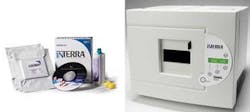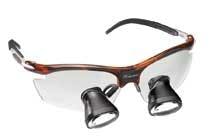Research yields harvest of benefits
by Dr. Joe Blaes
Dentist's Stool and Assistant's Stool from Midmark — You are probably thinking that this is just what I need — another set of operator stools. Please read on because these are very different. Midmark engineers and designers have come up with a system that offers premium styling and exceptional comfort in operator's stools that also addresses the musculoskeletal pains that we all know about. The ergonomic seating system offers a contoured seat with raised front to improve weight distribution and overall comfort, promoting a more balanced posture. Comfort is also enhanced with waterfall front edges that reduce pressure on the back of the thighs. Realizing that one stool does not fit everyone, these come with multiple seat sizes and seat heights that allow you to personalize your seating solution. The doctor's stool comes with optional, fully adjustable arm supports. The assistant's stool offers an optional ratcheted backrest, a ratchet release body support with height adjustment, and an integrated footrest that automatically adjusts with the seat height. I think you'll enjoy the comfort of this well-thought-out operator's seating system — we certainly do. Order from your dealer or visit www.midmark.com for more information.
iNterra™ INoffice Nightguard from DENTSPLY Caulk — Here is a great practice-building idea for you. More than 45 million Americans suffer from bruxism and/or temporomandibular disorder (TMD), but they are not being treated with a nightguard for many reasons. One of those reasons is that most nightguards are laboratory produced, so placing one is a two-visit proposition. The iNterra Nightguard system is produced quickly and easily in-house at one appointment. Because the iNterra material is formed directly on the teeth, the fit is improved and the appliance requires fewer adjustments. Once it is completely cured, you have a highly durable and wear-resistant nightguard. Your patients will like the convenience of one office visit. The iNterra nightguard is esthetic, stays in place, and is comfortable. No worries for your patients because the material is methyl methacrylate monomer-free. iNterra VLC material is rigid, yet has a subtle elasticity that cushions the teeth. This material is available in three tray sizes and comes ready to form on slightly moistened teeth with no mixing necessary. This product is definitely faster, better, and easier. Order from your dealer or visit www.caulk.com or call (800) LD-Caulk for more information.
Rudy Project sports frames from Orascoptic — The quality of a loupe system is governed by four key visual characteristics. Resolution is the capability to visualize small structures, and is established by the quality of the optical design and the use of precision lenses. Consider the widespread consumer appeal for high-definition televisions as a testimony to the value of resolution. Field width is the size of the operating site when viewed through loupes. Health-care professionals appreciate a wider field of view because it is easier and quicker to adjust when shifting from the naked eye to the loupe. A wider field also promotes less eye fatigue. Field width is linked to the diameter of the telescope, the optical design, and the magnifying power — the higher the power, the smaller the field. Field depth is the range of focus delivered by the loupe. This determines how much you can lean in, or lean back, while wearing your loupe, and still maintain focus of the entire viewing field. Field depth is dependent on the available lighting, the optical design, the magnifying power, and the eye’s ability to focus (accommodation). Magnification power is the size of the image (not the clarity of the image). There is no standard measurement for magnifyingpower in the loupe market. Since there is no standard to measure magnification, Orascoptic has adopted a simple system to promote the professional’s clear understanding of the choices available:
Class II magnification: between 2.0 and 2.9 power
Class III magnification: between 3.0 and 3.9 power
Class IV magnification: between 4.0 and 4.9 power
Other characteristics to consider in a loupe system include its weight, the angle of the telescopes, and the comfort and style of the frame. Orascoptic has added the fashionable carbon and tortoise colors to their popular line of Rudy Project sports frames, which is also available in black and platinum. The Rudy Project frames feature an adjustable nose pad and temple arms that afford a perfect, customized fit every time. The frames support Orascoptic's award-winning HiRes line of telescopes in Class II magnification and are also compatible with the complete line of Orascoptic Zeon headlight systems. Visit www.orascoptic.com for more information.
Protemp™ Plus temporization material from 3M ESPE — We need a name change in this field. The roles that a temporary restoration must fulfill have become more demanding over time. I prefer to call them "aesthetic provisionals" in my practice. The introduction of Protemp Plus now provides me with an advanced material that allows me to make my provisionals even more esthetic, quicker, and easier than ever before with more strength than Protemp 3 Garant. This new material is the latest development of a bis-acrylic composite crown and bridge material in the 10:1 Garant™ cartridge from 3M ESPE. Right from the beginning, the surface quality of Protemp Plus temporization material is obvious when compared to other materials. No more messy or sticky procedures, this material has tangibly less inhibition layer. Just wiping with ethanol will get the surface glossy and shiny immediately, making the whole procedure faster because the polishing and glazing working step is no longer required. Due to the smooth surface of this material, plaque can be easily removed and cleaned so the patient can maintain great gingival health, which is so vital to the seating appointment.
The high mechanical performance profile of this material translates not only into enhanced clinical safety, but also enhanced convenience for patients and dentists. This material with its fracture resistance and remarkable esthetics is well equipped to be the first choice for the most demanding discipline in temporization, the long-term temporary. This material comes in five fluorescent shades that are designed to match Filtek Supreme Plus flowable restorative. Based on my experience with Protemp 3 Garant, I would expect Protemp Plus provisionals to last well more than a year. There you have it — a new provisional material that has high fracture resistance and strength, high esthetics (built in), and easy handling for a fast procedure. Protemp Plus is my choice for beautiful esthetic provisionals. Order from your dealer or visit www.3mespe.com for more information.
Midwest Caries ID™ from DENTSPLY Professional — We all know of the need to have more efficient and effective means to detect early carious lesions. We need a method beyond manual and X-ray methods which we now know are marginally effective. The Midwest Caries ID detection handpiece is an aid in identifying the presence of occlusal and interproximal caries in molars and pre-molars. The detection handpiece is recommended for use in the detection of caries in pits and fissures and interproximal areas on posterior teeth that have not been restored. This handpiece system uses Light Emitting Diode (LED) and fiberoptic technologies to accurately detect both occlusal and interproximal caries. The presence of either type of lesion is identified by two signals: an audible tone, and a visual signal on the tooth. It requires only a clean tooth surface, free of plaque and calculus prior to use to be effective. An absence of the red light and audible tone indicates that the tooth structure is caries free. The presence of the red light and the audible tone indicates a decalcification cation of the tooth structure. During the tooth surface mapping, which includes interproximal surfaces, the handpiece will emit beeps ranging in speed (from slow to rapid) while illuminating the tooth in red to indicate the presence and location of caries. The aim of the Midwest Caries ID is to enhance the detection of caries by augmenting the clinician's knowledge of caries development. A large positive detection surface indicates a strong possibility of a large quantity of underlying decay. I urge you to discover a great new system to augment your detection of carious lesions. Order from your dealer or visit www.cariesid.com for more information.





